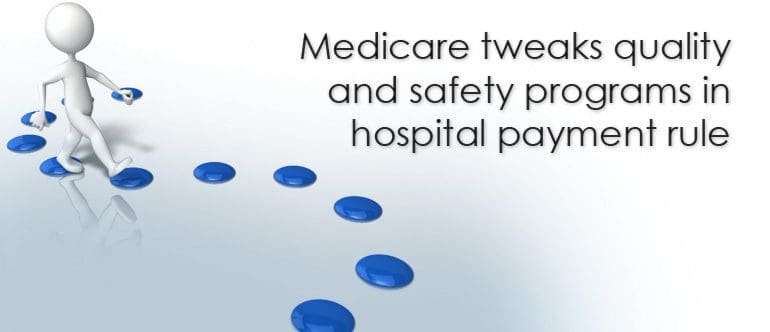Call us toll-free: 800-878-7828 — Monday - Friday — 8AM - 5PM EST


By Sabriya Rice for Modern Healthcare
The CMS floated a slate of tweaks to Medicare’s quality- and safety-reporting requirements in its sweeping proposed rule for 2016 inpatient hospital rates issued last week.
Within the 1,500-page draft rule for the Hospital Inpatient Prospective Payment Systems, the CMS outlines changes coming down the pike for the hospital inpatient quality reporting, excess readmission, hospital-acquired condition and value-based purchasing programs. Some changes can be anticipated as early as fiscal 2016.
Health policy researchers from the American Hospital Association who reviewed the document flagged several “significant changes” for U.S. hospitals in coming years. They include a shift from voluntary to required submission of electronic clinical quality measures and possible expansions to the population of patients included within certain measures.
The programs are part of the federal agency’s continued shift toward paying hospitals for the value of care rather than volume of services provided to Medicare beneficiaries. The changes would impact policies and rates for inpatient discharges for approximately 3,400 acute-care and 435 long-term-care hospitals.
If the proposed changes become final, hospitals can expect changes to the hospital-acquired condition (HAC) and hospital inpatient quality reporting (IQR) programs in fiscal 2016.
Proposed changes to the HAC program include expansion of the population covered by the central line-associated bloodstream infection (CLABSI) and catheter-associated urinary tract infection (CAUTI) measures to include patients in select, non-intensive care unit sites within a hospital.
The CMS is also proposing a policy that would allow hospitals that experience disasters such as hurricanes or floods to request a waiver to suspend reporting during the affected time periods.
Also of note are potential reductions for facilities that fail to participate in the IQR program and have not met the federal criteria for the meaningful use of electronic health records. Although there is a proposed 1.1% increase in operating payment rates for general acute-care hospitals that successfully participate, hospitals failing to submit required quality data will be subject to a 25% reduction of that rate bump, and the reduction will be 50% for those that aren’t meaningfully using EHRs.
According to the proposal, the CMS anticipates EHRs will continue to improve on capturing relevant clinical data and plans future expansion of the list of core clinical data elements. But Akin Demehin, senior associate director of policy for the American Hospital Association, expressed concern about the requirement.
“We’re still very much in a learning phase with respect to generating accurate data from electronic clinical quality measures,” he said. “The results that are being generated are just not accurate enough for either internal quality improvement purposes or for the public reporting purposes that’s really the heart of the IQR program.”
For fiscal 2017, the CMS is proposing a major refinement to a pneumonia measure in its readmission program. The change would expand the population cohort to include, for example, patients with a principal discharge diagnosis of either sepsis or respiratory failure who also have a secondary diagnosis of pneumonia present on admission.
“That’s very significant,” and the AHA is seeking more understanding on this measure, Demehin said. “It means that the national readmission rate for pneumonia is changed and the individual hospitals’ performance on the pneumonia measure also changes.”
The CMS says the expansion would better represent the complete population of those receiving clinical management and treatment for the condition. It also would ensure the measure includes more complete and comparable populations across hospitals, according to the rule. The cohort of patients would increase by 65%, or an additional 634,519 patients and data would be included for 42 additional hospitals.
By 2018, the federal agency proposes to remove nine measures from the hospital inpatient quality reporting program, including some that are considered “topped out,” meaning hospitals generally perform so well on them that there’s little room for improvement. However, hospitals will be asked to continue to report on several of them within the electronic clinical quality program.
For example, the document lists measures of patients discharged on statin medication, stroke education and fibrinolytic therapy received within 30 minutes of hospital arrival.
Nancy Foster, the AHA’s vice president of quality and patient safety policy, questioned the value of one program retaining measures considered topped out by another program. “If a measure is no longer valued as part of the chart-abstracted measures because the performance is uniformly good, then it makes no sense to require it as part of an EHR incentive program,” she said.
Hospitals and other groups will have the opportunity to share their concerns. The CMS will accept comments until June 16 and plans to deliver a final rule by Aug. 1.
